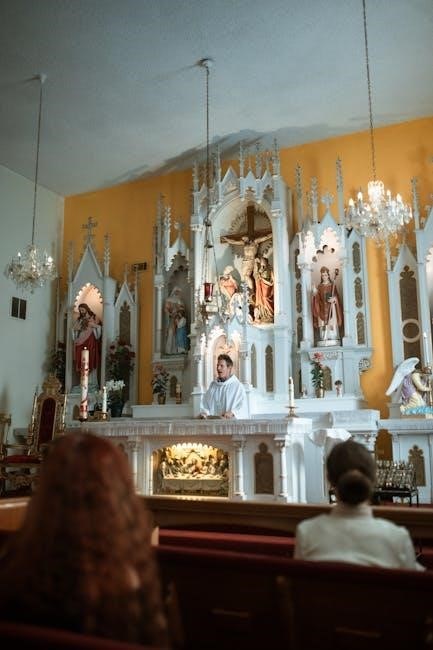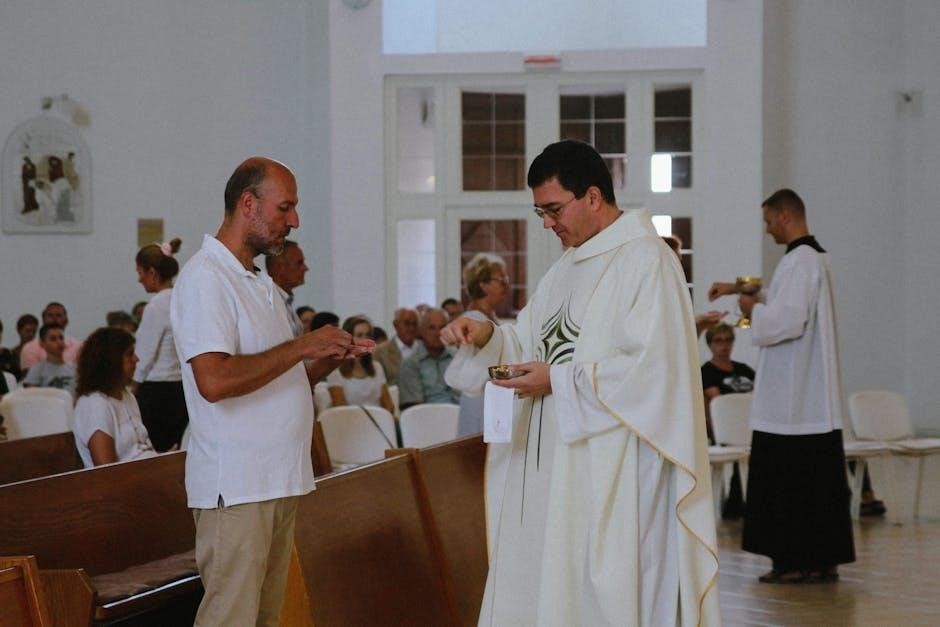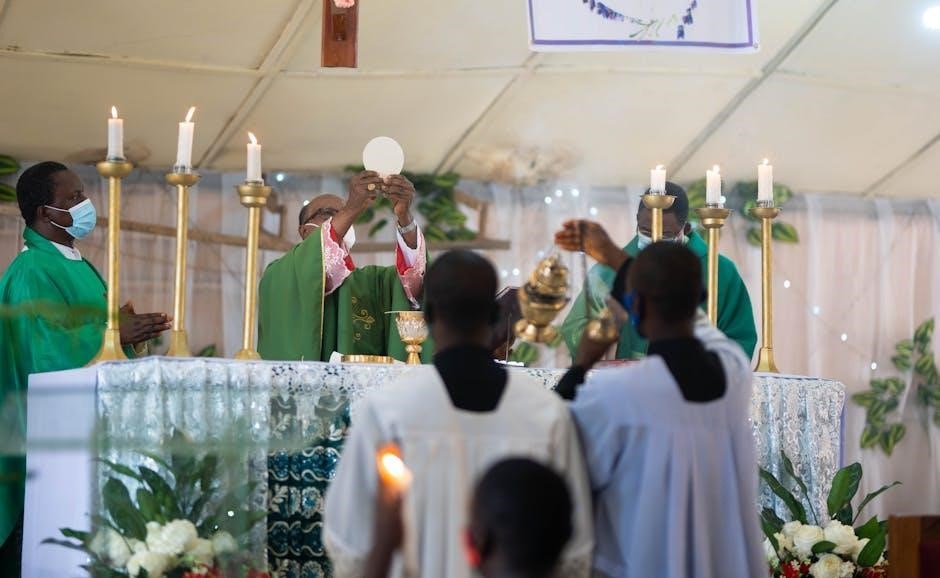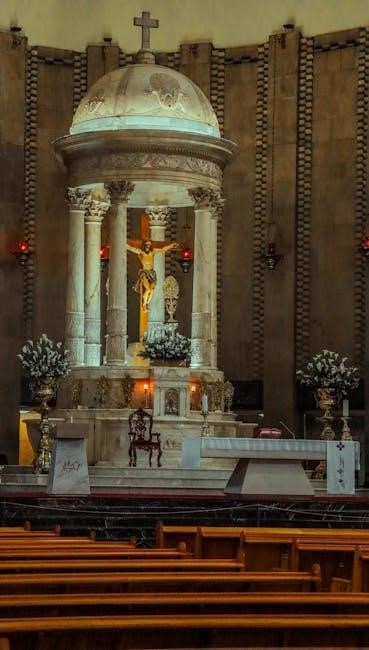The Roman Catholic Funeral Mass Order of Service is a structured ceremony celebrating the deceased’s life, offering comfort through prayer and tradition.
1.1 Overview of the Funeral Mass Structure
The Roman Catholic Funeral Mass follows a structured sequence, beginning with Introductory Rites, including the entrance procession, sprinkling of holy water, and placement of the pall; The Liturgy of the Word features readings from the Old and New Testaments, a responsorial psalm, and a homily. The Eucharistic Liturgy includes the presentation of gifts, the Eucharistic Prayer, and Holy Communion. Concluding Rites involve the Final Commendation and Recessional Hymn, followed by a procession to the cemetery. This structure ensures a meaningful and reverent celebration of the deceased’s life.
1.2 Importance of the Order of Service in Catholic Funerals
The Order of Service in a Roman Catholic funeral provides a meaningful framework for honoring the deceased while offering comfort to mourners. It ensures the ceremony adheres to Catholic traditions, emphasizing prayer, reflection, and communal support. The structured sequence helps guide the congregation through the liturgy, fostering unity and dignity. By following the established rites, families can focus on their faith and the celebration of their loved one’s life, trusting in the Church’s time-honored practices to provide solace and spiritual strength during their grief.

Introductory Rites
The Introductory Rites initiate the Funeral Mass, featuring the entrance procession, sprinkling of holy water, and placement of the pall, symbolizing baptismal purity and Christian dignity.
2.1 Entrance Procession and Greeting
The Funeral Mass begins with the Entrance Procession, where the priest, accompanied by the family, enters the church. The casket or urn is carried or wheeled in, often to the sound of a hymn or sacred music. The priest greets the family and the assembly, offering a sign of faith and hope. This rite symbolizes the community’s gathering to pray for the deceased and find comfort in the Church’s liturgical tradition, emphasizing the resurrection and eternal life.

2.2 Sprinkling with Holy Water
The casket or urn is sprinkled with Holy Water as a reminder of the deceased’s Baptism and the hope of eternal life. This ritual, often performed at the entrance of the church or near the baptismal font, symbolizes purification and spiritual renewal. It reflects the Catholic belief in the transformative power of sacred rites and the soul’s journey toward God. This act is a comforting tradition, deeply rooted in Catholic liturgical practice, and is performed with dignity and reverence.
2.3 Placing of the Pall
The pall, a large white cloth, is placed over the casket or urn, symbolizing the equality of all in death and the unity of baptism. This simple, dignified act reminds us of the deceased’s Baptism and their call to eternal life. The pall is often placed by family members or funeral staff, serving as a visual reminder of the Christian hope and the soul’s journey to God. It is a meaningful tradition that underscores the universal equality in faith and death.
Liturgy of the Word
The Liturgy of the Word includes readings from Scripture, a responsorial psalm, and a homily, offering comfort and hope through God’s Word.
3.1 First Reading (Old Testament)
The First Reading is selected from the Old Testament, offering themes of hope, mercy, and redemption. A family member or designated reader typically presents this passage, which reflects God’s promise of eternal life and resurrection. The reading provides comfort and connects the deceased’s life to God’s larger narrative. It is chosen from the Order of Christian Funerals, emphasizing trust in divine plan and paving the way for the Gospel message.
3.2 Responsorial Psalm
The Responsorial Psalm is a sacred song of praise, typically sung by the assembly, that reflects themes of trust in God and hope for eternal life. Rooted in the Old Testament, it provides a musical interlude following the First Reading, offering comfort to mourners. The psalm is chosen to resonate with the deceased’s life and faith journey, serving as a bridge between the Old and New Testament readings. Its melody and lyrics uplift the spirit, fostering a sense of communal prayer and reflection.
3.3 Second Reading (New Testament)
The Second Reading, drawn from the New Testament, emphasizes themes of resurrection, eternal life, and hope in Christ. Often selected from epistles like Corinthians or Revelation, it offers comfort to mourners by reaffirming God’s promise of salvation. This reading bridges the Old Testament’s anticipation with the New Testament’s fulfillment, deepening the congregation’s reflection on faith and eternal life. A family member or friend typically proclaims this passage, connecting the broader Christian story to the deceased’s life and legacy.
3.4 Homily
The Homily is a heartfelt reflection by the priest, connecting the scripture readings to the life of the deceased and the hope of resurrection. It offers comfort to the mourners by emphasizing God’s love and the promise of eternal life. While not a eulogy, the Homily may include personal reflections on the deceased’s faith journey, tying it to the Gospel message. This sacred moment invites the congregation to find solace in their faith and the assurance of eternal rest.

Eucharistic Liturgy
The Eucharistic Liturgy is the heart of the Funeral Mass, where the bread and wine are consecrated into Christ’s Body and Blood, uniting the deceased with Him.
4.1 Presentation of the Gifts
The Presentation of the Gifts is a sacred moment in the Eucharistic Liturgy where the offerings of bread and wine are brought to the altar. This act symbolizes the community’s participation in the sacrifice and preparation for the Eucharist. Family members or designated individuals typically present the gifts, often accompanied by a hymn or sacred music. The priest then prepares the altar, placing the offerings on it as a sign of gratitude and sacrifice, reflecting the deceased’s union with Christ’s offering.
4.2 Eucharistic Prayer
The Eucharistic Prayer is the heart of the Funeral Mass, where the priest leads the assembly in thanking God for the gift of salvation. The prayer includes the consecration of bread and wine into the Body and Blood of Christ. It also remembers the deceased, asking God to welcome them into eternal life. This sacred moment unites the deceased with Christ’s sacrifice and offers comfort to the mourners, reinforcing the hope of resurrection and eternal life.
4.3 Holy Communion
Holy Communion is a sacred moment in the Funeral Mass where the congregation receives the Eucharist, symbolizing unity with Christ and the deceased. The priest distributes the consecrated hosts to the mourners, offering spiritual comfort and strength. This rite reinforces the belief in eternal life and resurrection, providing solace to those grieving. Non-Catholic attendees may participate by praying or receiving a blessing, emphasizing communal support and shared faith.
Concluding Rites
The Concluding Rites bring the Funeral Mass to a close, offering final prayers for the deceased and preparing for their journey to eternal rest.
5.1 Final Commendation
The Final Commendation marks the transition from the Funeral Mass to the burial. The priest prays for God’s mercy and peace for the deceased, seeking eternal rest. Family members may place the pall or cover the casket with a white cloth, symbolizing baptismal purity. The rite concludes with a blessing, often including holy water, before the procession to the cemetery begins. This moment emphasizes the community’s farewell and trust in God’s promise of eternal life, comforting the grieving family and friends.
5.2 Recessional Hymn
The Recessional Hymn marks the conclusion of the Funeral Mass, sung as the casket is carried out of the church. This hymn, chosen by the family, reflects the deceased’s faith and offers comfort to mourners. It serves as a final farewell, honoring the loved one while providing hope in eternal life. The hymn accompanies the procession to the cemetery, symbolizing the soul’s journey to eternal rest and the community’s collective prayer for the deceased. It is a meaningful conclusion to the Mass.
5.4 Funeral Procession to the Cemetery
The Funeral Procession to the Cemetery follows the Recessional Hymn, where the casket is carried out of the church. The priest leads the procession, accompanied by pallbearers, family members, and mourners. The casket is transported to the cemetery, symbolizing the final journey of the deceased to their resting place. This solemn procession reflects the community’s support and prayerful accompaniment, ensuring the deceased is honored until their final commendation. The procession concludes with a graveside service and the Rite of Committal.

PDF Template for Funeral Mass Order of Service
A PDF template for the Roman Catholic Funeral Mass Order of Service provides a structured and visually appealing format to outline the ceremony. It includes sections for the entrance procession, readings, hymns, and the Eucharistic Prayer. Families can personalize the template with photos, scripture selections, and musical choices. The template ensures all elements of the service are organized, offering a respectful and dignified tribute to the deceased. It is easily downloadable, editable, and printable, making it a practical tool for funeral planning.



